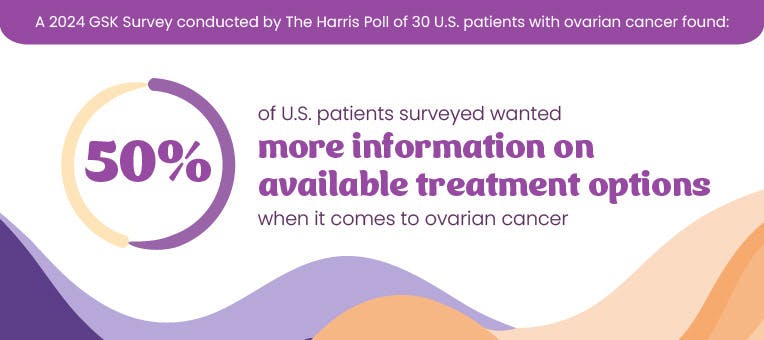You are about to leave OurWayForward.com.
You are about to leave a GSK website. By clicking this link, you will be taken to a website that is independent from GSK. The site you are linking to is not controlled or endorsed by GSK and GSK is not responsible for its content.
Determining Your Ovarian Cancer Treatment Plan

What are My Treatment Options?
Treatment plans for ovarian cancer can vary between patients for several reasons, including the stage of diagnosis. After diagnosis, there are several steps that you and your healthcare professional can take to develop a treatment plan, which may include surgery, chemotherapy, and/or maintenance therapy.
Surgery
Surgery is the first step in treating most stages of ovarian cancer. After surgery, patients usually receive chemotherapy, especially if the cancer is not in an early stage. It’s the most common treatment for ovarian cancer, when possible, and may include:
- Total or simple hysterectomy (removing the uterus and cervix)
- Radical hysterectomy (removing the uterus, tissues next to the uterus, and part of the vagina)
- Bilateral salpingo-oophorectomy (removing both ovaries and fallopian tubes)
- Lymph node dissection (removing the lymph nodes from the pelvis and around the aorta and checking a sample of tissue for signs of cancer)
There are 2 main goals of surgery:
- To determine the stage of ovarian cancer
- Removing as much of the tumor as possible, known as debulking
Systemic Treatments for Ovarian Cancer
These treatments can affect cells, both cancerous and healthy, throughout the body. Treatments are either injected or taken orally.
Chemotherapy
Chemotherapy can be given either before (neoadjuvant) or after (adjuvant) surgery or as a primary treatment even if surgery isn't incorporated into your treatment plan.
Targeted Therapy
These medications attack parts of cancer cells that are different from healthy cells in the body and are given after surgery and/or as the disease progresses.
Hormone Therapy
Hormone therapy can be used to either add or block hormones to help fight cancer cells. This type of therapy can be given after surgery or as a treatment option if your disease has progressed. It is mostly used in patients with ovarian stromal tumors and is less commonly used for patients with epithelial ovarian cancer.
Immunotherapy
Immunotherapy helps a person’s own immune system better recognize and kill cancer cells. The immune system normally keeps itself from attacking the body’s healthy cells. It does so by using “checkpoint” proteins on immune cells, which act like switches that need to be turned on to start an immune response. Cancer cells turn these checkpoint proteins off to avoid getting attacked by the immune system. Immunotherapies can be used to treat some endometrial cancers by switching the immune response back on.
Antibody-Drug Conjugates
Antibody-drug conjugates are specific treatments designed to target and kill tumor cells with chemotherapy drugs. They’re made of three parts: an antibody specific to the type of cancer being targeted, a certain type of chemotherapy drug, and a connecting protein to hold the two parts together. Antibody-drug conjugates are typically administered through a vein. The antibody part of the drug targets cancer cells, which pull the drug inside. The connecting protein then releases the chemotherapy drug inside the cancer cell to kill it.
Maintenance Therapy
While observation, or “watch and wait,” was previously standard practice in monitoring for recurrence after initial chemotherapy treatment, there are more options available to help manage the disease. Maintenance therapy may help delay the time before the cancer returns, which is also known as progression-free survival (PFS). It is given after a positive response to chemotherapy to help keep cancer from returning and can help extend PFS at various stages of disease. In certain patients, maintenance therapy has been shown to help delay recurrence, regardless of tumor characteristics (BRCA and HRD).
There are currently two FDA-approved classes of maintenance therapy available for patients with ovarian cancer:
- Poly (ADP-ribose) polymerase (PARP) inhibitors
- A PARP inhibitor may prevent cancer cells from repairing their damaged DNA, which can cause them to die. This may slow the return or progression of cancer. It can also impact other cells and tissues in the body.
- PARP inhibitors are typically prescribed as oral pills.
- If you or a loved one are facing advanced ovarian cancer, talk to a healthcare professional about maintenance therapy. Learn more about a PARP inhibitor treatment option.
- Vascular endothelial growth factor (VEGF) inhibitors:
- Normal cells make VEGF, but some cancer cells make much more.
- Blocking VEGF may prevent the growth of new blood vessels, including normal blood vessels and blood vessels that feed tumors.
- VEGF inhibitors are typically administered using IV (intravenous) drips.
Clinical Studies
Researchers are always looking for ways to improve upon and develop new treatments for cancer. To do this, they conduct clinical studies, which evaluate how safe treatments are and how well they work. Clinical studies often provide an opportunity to get early access to new therapies and can be considered an integral part of your treatment plan, not just a "last resort.” Learn more about clinical studies here.